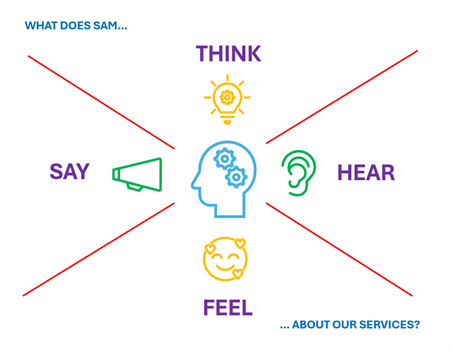In my introductory blog on Design Thinking, I mentioned its 5 stages. The first of these is “Empathise”.
You may ask “But why bring empathy into pensions?”. Checking your projected pension or receiving a correct payment each month - surely this is all just about operational efficiency? Whilst that’s often true, the reality is that most people only engage with their pension funds or employers about their pensions during life events. These might be work-related such as a change in role or employer, or personal circumstances such as going through a divorce or having a baby. These are moments where any decisions made can have real consequences and are often at times of heightened emotion.
So, efficiency is only one side of the equation. That’s why we need to go beyond the process and ask: what is the human experience behind each interaction?
If Design Thinking is less about operational efficiency and more about delivering effective services, then empathy is where it all begins. It’s the foundation of everything that follows, because unless we truly understand the people we’re designing for, even the best ideas risk missing the mark.
Whether you're managing funds, shaping member communications, or designing digital tools, empathy helps you see the system through someone else’s eyes: a scheme member approaching retirement, a councillor under pressure to deliver more with less, or an officer navigating legacy systems.
Empathy isn’t just about being nice
Because it deals with emotional responses and reactions, it’s easy to think of Design Thinking as quite a “fluffy” idea centred around sentimentality. But this is a common misunderstanding. It’s about objectively understanding people’s goals, pain points and motivations, so we can design services that meet real needs. In practice, it’s as analytical as much as it is emotional (if not more so).
Let’s take a practical example. Suppose member take-up of a digital self-service platform is lower than expected. The technical solution might work perfectly. But what if the member journey is unclear? What if key features are buried under jargon? Or if scheme members are worried about data security, but haven’t had that fear addressed?
Without empathy, those questions can be missed entirely. With it, they become the basis of better, more effective interventions.
Empathy mapping
Empathy mapping is a particularly simple yet powerful framework for understanding the end-users of our services.
It involves firstly being specific about who we are looking to understand. This “persona” is normally defined in terms of their demographics and lifestyle. For example…
“Sam, an 18-year-old school leaver, who has just started his first job with the council in Sport and Leisure, as a swimming development apprentice. Outside of work, much of his life revolves around sport. He goes to the gym 3 times a week and is an avid tennis player. He also enjoys going to watch the local football team with his dad on a Saturday. He is right at the beginning of his career journey and so have not considered his retirement plans in any great detail.”
You can see that even a simple description of this person can provide a much richer picture than our normal categories of “Active”, “Deferred” or “Pensioner”.
Once you have this persona specified, you can build a picture of how they might experience your service.

Each of these questions can be answered either based on research (in the case of “say/hear”) or by directly discussing with a person or group who broadly fall into that persona (the “think/feel” element).
Consciously working through a framework, and asking questions such as these, can provide extremely useful insights as we start to consider the needs of our users.
It involves active listening, observation, and asking thoughtful questions, not to validate what we think we know, but to reveal what we don’t.




